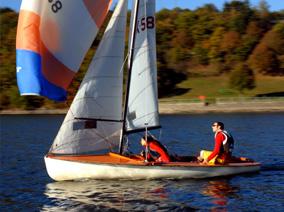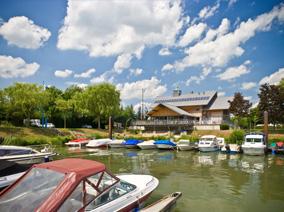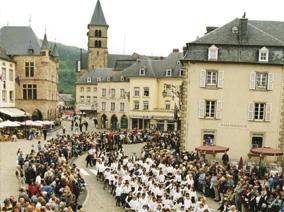The Nature Park of the Upper Sûre - Winner 2010

Winner in the Aquatic Tourism category
The Nature Park of the Upper Sure is located in the north-western part of Luxembourg, close to the Belgian border.
The countryside is marked by narrow, deep meadowed valleys and steep forested slopes, as well as a mosaic of fields on the high plateau of the Ardennes.
At the heart of the park is the Upper Sure Lake, the largest area of water in Luxembourg which provides 70 percent of the population with drinking water.
The surrounding countryside consists of wooded hills, streams and small villages. Water activities are allowed on most of the lake, and the rivers are popular among canoeists. There are several cycle routes, long and short distance walk paths around the villages.
What makes the Nature Park of the Upper Sure special?
Consisting of plateaus, narrow valleys with wooded slopes, the lake of the Upper Sure dam, built in the late 1950s to meet the country’s drinking water requirements, has since become one of the most coveted places to take a rest or a holiday, especially during the summer months.
A great way to discover the area is to make a boat-trip on the dammed lake with a solar powered boat. While silently gliding over the water one not only gets an impression of the region's diverse flora and fauna, but also listens to its authentic sounds, such as the croaking of different frog species.
Other examples of its staggering wildlife include the European otter, the black stork and the rare hazel grouse.
Don't miss...
- sailing on the Upper Sure Lake
- the solar powered boats - a perfect way to enjoy the beautiful scenery of the lake
More information
- The official website for the Nature Park of the Upper Sure
- Watch the EDEN video about Nature Park of the Upper Sure:
- Long version (3 minutes)
- Short version (1 minute)
- EDEN contact for Nature Park of the Upper Sure: christine [dot] lutgen
 naturpark-sure [dot] lu (christine[dot]lutgen[at]naturpark-sure[dot]lu)
naturpark-sure [dot] lu (christine[dot]lutgen[at]naturpark-sure[dot]lu)
Haff Reimech Recreation Area and Nature Reserve - Winner 2009

Winner in the Tourism and Protected Areas category
A major attraction is the 42-kilometer long 'Wine Road' that starts on the Luxembourg Moselle River. The route winds its way through gorgeous lands dotted by many exquisite wineries. Stopping to taste some of the wines is a must.
Nature walks through the commune's green forests are highly appreciated by tourists. The Haff Reimech trail takes visitors through many of the zone's exclusive lands and scenic observation points. One of the stops on the Haff Reimech is dedicated solely to bird-watching and has an observation post that allows enthusiasts to view birds in their natural habitat.
Swimming lakes and water sports are also enjoyed by visitors. There is an artificial beach that allows swimming and canoeing, as well as beach volleyball.
What makes the region special?
The 'Three Border Region', comprised of the Commune of Schengen, French towns Sierck les Bains and Apach, along with German neighbor Perl (Saarland), is a district rich in cultural tradition. Cultural diversity is strongly promoted and is aimed at raising awareness in respecting each country's traditions.
The immense respect the region has for nature and wildlife is truly amazing. The Three Borders Nature Park plans to build a crossing that runs through the Pferdemosel, which is the area between the Saarland villages of Besch and Nennig (Perl). It will run adjacent to the man-made lakes, which are an important habitat for the park's birds. This crossing will allow visitors to cross the Moselle river without using cars.
The Commune of Schengen continues to explore ideas and make improvements in the region. But expansion of the region's facilities has not been detrimental to the environment. Much of the area lies in a protected zone and procedures have been taken to ensure eco-friendly development.
What to do in...
- spring: Take the 'Wine Road' filled with wine devotees.
- summer: Enjoy lakeside beach volleyball games.
- autumn: Watch the fishermen testing their luck in lake waters.
- winter: Join eager foodies enjoying the local cuisine.
Other highlights
- Visit three countries in one day.
- Spend a quiet afternoon on the Half Reimech trail.
- Catch some rays at the beach.
- Enjoy a lively wine festival.
More information
- The official website of the Schengen Commune
- The website of the Haff Reimech Nature Reserve
- Watch the EDEN video about the Haff Reimech Nature Reserve:
- Long Version (3 minutes)
- Short Version (1 minute)
- EDEN contact for the Haff Reimech Nature Reserve: martina [dot] kneip
 schengenasbl [dot] lu (martina[dot]kneip[at]schengenasbl[dot]lu)
schengenasbl [dot] lu (martina[dot]kneip[at]schengenasbl[dot]lu)
La Ville D'Echternach - Winner 2008

Winner in the Tourism and Local Intangible Heritage category
Echternach is located in eastern Luxembourg where the Sauer River forms the border between Luxembourg and Germany. It lies within the German-Luxembourgian Nature Park and the rocky landscapes of Mullerthal, the 'Little Switzerland' of Luxembourg.
The city and its abbey were founded by St Willibrord in 698 whose missionary action made it a starting point for Carolingian renaissance when he evangelised the region.
Sightseeing
Echternach is a town which prides itself on its cultural heritage, welcoming tourists to a centre of culture that has been attracting visitors since the middle ages.
An example of such a long lived tradition is the dancing procession of Echternach. For the last 500 years this has been associated with the death of the English monk, St Willibrord – although the precise reason for the connection has been lost in the mists of time.
The procession takes place annually on Whit Tuesday. Local legend has it that the pilgrims who flowed to Echternach when St Willibrord died might have observed a sacred dance in his honour, and that this inspired a ritual procession (despite the Church forbidding sacred dances well into the century of enlightenment). However, there is slim proof of this, and it might simply be local colour.
In 2010, the dance procession was listed by UNESCO as an Intangible Cultural Heritage.
The Echternach scriptorium is housed in the old abbey founded by St Willibrord. At the time the abbey was the cradle of a civilisation whose cultural and religious blossoming paved the way to the creative movement of Carolingian renaissance. Inspired by missionary zeal, the monks of Echternach installed a scriptorium in order to reproduce evangelical scrolls brought in from the Anglo-Saxon isles.
Echternach has hosted an international music festival and the cultural exchanges connected to it since 1975. The international reputation of Echternach’s music festival has turned this "small town with a great past" into a high-ranking music scene in May and June.
The opening of TRIFOLION, a new cultural, tourism and congress centre in April 2008 has underlined the importance of congress tourism and its impact on Echternach’s economy.
Don't miss
- the Museum of Prehistory: a private collection exhibited in a building dating back to the 15th century, traces life in a big region back to palaeolithic and neolithic times.
- the Roman Villa (INFOFORUM): located in close proximity to the big Roman villa, this INFOFORUM describes the daily life of a Gallo-Roman family by means of life-size models in several scenes.
- the Abbey Museum: the vaulted cellars of the Benedictine abbey built between 1727 and 1734 harbour middle age manuscripts. In 1998 impressive testimonials on the cult of St Willibrord were added.
- the Documentation Centre on the dancing procession: this museum was inaugurated in April 2008 and presents the history of the dancing procession in a small indoor courtyard. The centre was welcomed by the pilgrims and supporters who flock to Echternach all year round.
- the architectural influence of Echternach Abbey: the park’s Rococo pavilion presents films, models and commentaries explaining the abbey’s influence on 18th-century rural architecture.
Sightseeing tips
If the visitor would rather explore the cultural heritage of Echternach by strolling around in the fresh air, the tourist board has established a series of themed walks.
Those with a clear idea of how significant the city’s history is established the walks in a bid to share the richness of the past with both local citizens and visitors.
- Via Epternacensis: a 2.2km circuit through the medieval centre and the main monuments, launched in 2000 with great success.
- Bicephal Eagle: a cross-border circuit launched in 2007, showing the influence of Echternach Abbey on 18th-century rural architecture.
- Roman Road: the Roman Palace of Echternach is part of the big cross-border circuit which evolved alongside the German and Luxembourgish Moselle river and was launched in 2007.
- In the steps of St Willibrord: in the context of the celebration of St Willibrord’s Jubilee Year in 2008, a working group created an itinerary connecting religious sites dedicated to the cult of St Willibrord who evangelised the big region. On the German side, a 'Willibrorduskulturweg' was presented leading to the German and Luxembourgian villages in Echternach’s proximity.
More information
- The official Echternach website
- Watch the EDEN video about Echternacht:
- Long version (3 minutes)
- Short version (1 minute)
- EDEN contact for Echternacht: echevin
 echternach [dot] lu (echevin[at]echternach[dot]lu)
echternach [dot] lu (echevin[at]echternach[dot]lu)
